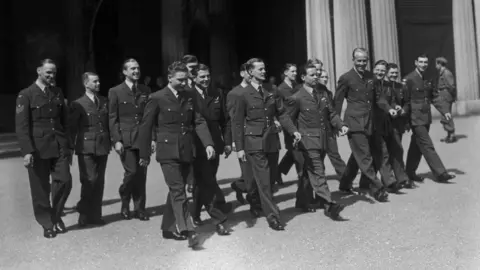Dambuster Guy Gibson's Victoria Cross on show
 Energycell.co.uk
Energycell.co.ukA Victoria Cross awarded to Wing Cdr Guy Gibson - who led the famous Dambusters raid during World War II - is going on public display for the first time in almost 30 years.
Wing Cdr Gibson was awarded the VC for his part in the 1943 raid on Germany in which he commanded 617 Squadron.
It will go on display at The Collection Museum in Lincoln.
David Harrigan, from the museum, said: "I can't tell you how important this is. We are honoured to have it."
Wing Cdr Gibson, who flew out of RAF Scampton in Lincolnshire, was killed when his plane crashed on its way back from another mission in Germany the following year.
 Energycell.co.uk
Energycell.co.ukMr Harrigan, who has been involved in organising the exhibition at the museum, said: "The medal hasn't been seen in public since 1992 and it's only been on public display three times since his death in 1944 - and all those were in London."
He said it was the first and probably only time the medal would be on display in the county.
"So, we are very grateful to the RAF Museum in Hendon."
 Getty Images
Getty ImagesOther exhibition highlights include artefacts from pilot Douglas Bader's career and his time in Colditz prison, and a decommissioned nuclear bomb.
Animal bravery is also recognised. One exhibit features a medal awarded to a pigeon which flew hundreds of miles carrying a message notifying officials of a plane crash.
"What we wanted to do was bring together some of the incredible and forgotten stories about Lincolnshire's contribution to the defence of this country," Mr Harrison added.
The exhibition, called A Century of Valour, runs until 15 March.

Dambusters raid
 Getty Images
Getty Images- The audacious attack on German reservoirs in the Ruhr Valley with "bouncing bombs" was a major coup for the British
- Immortalised in the Dambusters film, the aim was to flood a vast area in one raid
- 19 bombers left RAF Scampton, near Lincoln, in three waves on the night of 16 May 1943. The first headed to the Möhne and the Eder Dams, the second and third to the Sorpe dam
- Out of the 133 crew that set off, only 77 returned
- The Sorpe Dam was damaged but the Mohne and Eder Dams were destroyed, flooding the Ruhr valley and killing an estimated 1,300 people, mostly civilians

Follow BBC East Yorkshire and Lincolnshire on Facebook on Twitter, and Instagram. Send your story ideas to [email protected].
